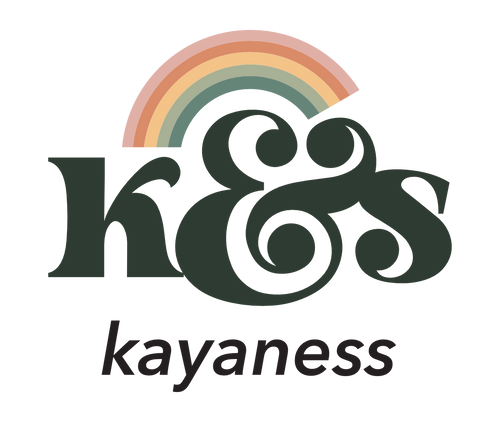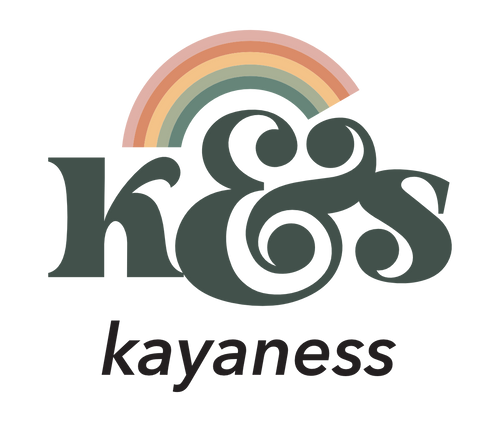Basic Product Function
How does kayaness® Menstrual Underwear function?
Our leakproof underwear relies on innovative technology with a moisture-separating gusset that effectively wicks away wetness, leaving your skin feeling drier for an extended period. The thin yet remarkably absorbent inner layer can absorb up to three times its weight in liquid, retaining moisture beneath the initial layer until it's time for washing. This unique combination ensures that our underwear is more comfortable, thinner, and drier compared to other period care options on the market.
How much flow can kayaness® Menstrual Underwear absorb?
Our underwear is heavy absorbency and can hold 3-4 regular tampons worth of flow.
What is kayaness® Menstrual Underwear made of?
The exterior body fabric is 100% Recycled Polyester. The gusset fabric (portion of the underwear in contact with your genitals) is 95% Organic Cotton and 5% Spandex. The inner absorbent layer (sealed inside the underwear and not in direct contact with genitals) is 100% Polyester. Our high standard for our fabrics differentiates us from other menstrual underwear brands which are typically made entirely from virgin polyester.
What is the kayaness® Menstrual Underwear absorbent pad made of?
The custom manufactured absorbent pad is constructed using multiple tiers of polyester-based material. The upper layer efficiently draws moisture away from the body, ensuring a dry and comfortable feeling. Intermediate layers soak up and retain moisture, while the lower layer, resistant to leaks, securely contains everything within the underwear. The pad is 100% polyester and does not come into direct contact with your skin. The gusset portion of the underwear that comes into contact with skin and genitals is made from 95% Organic Cotton and 5% Spandex.
Sustainability
What makes Kayaness a sustainable brand?
At Kayaness, sustainability is at the core of our mission. Our products are designed to be reusable and made from sustainable materials like organic cotton and recycled polyester.
We do not use a third party factory - our factory is family-owned by our co-founder, Ro Kumar, who is also the founder of the well known toothbrush brand, Brush with Bamboo®. Our factory is an ISO9001 certified facility. We ensure that all workers in our manufacturing facility work under safe conditions and all are paid a fair living wage. Most of the workers on our team have been with us for over 10 years.
Our products are also third-party tested for safety, and we publish our test results for full transparency.
Are your sustainability claims verified by third parties?
We’re working to ensure our materials are certified by recognized organizations. While we currently publish safety test results for our products, we aim to achieve certifications like GOTS (for organic cotton) and B-Corp status.
Please note that attaining GOTS organic certification requires larger fabric orders than we’re currently able to achieve, and B-Corp certification requires businesses to operate for at least 12 months before applying, and the entire process can take 2-3 years to complete.
Materials
Why Organic Cotton?
Regular cotton can use harsh synthetic pesticides, a lot of water, and fertilizers, which can harm ecosystems and farmers. Organic cotton, on the other hand:
- Skips the nasty chemicals. It’s grown without synthetic pesticides and fertilizers, which means fewer pollutants in the soil, water, and air.
- Saves water. Organic farming methods often use rainwater and more efficient irrigation, cutting down on water waste.
So, compared to conventional cotton, organic cotton is more gentle on the planet and the people growing it.
Why recycled polyester?
Polyester is typically made from fossil fuels (ouch, not great), but recycled polyester (rPET) is made by repurposing things like old plastic bottles or discarded textiles. Here's why that’s better:
- Fostering recycling. Recycling can’t take place without companies being willing to buy and use recycled materials in their products so we’re aiming to add this circularity to our supply chain.
- Keeps plastic out of landfills and oceans. Instead of trashing plastic, it gets a second life as fabric, reducing waste.
- Cuts down on virgin plastic production. That means less reliance on oil and gas and fewer greenhouse gas emissions during production.
- Reduces energy use. Making rPET uses significantly less energy than producing brand-new polyester.
Plus, polyester is super durable—when you’re making products meant to last, polyester creates structure, integrity, and stretch that allows the product to maintain durability through even the toughest of wear. By using recycled poly, we can provide that same resilience in a more eco-friendly way.
Why Organic Cotton + Recycled Polyester?
Durability = Less Waste.
Organic cotton is soft and breathable, while recycled polyester is strong and long-lasting. Combining them means you get the best of both worlds: a product that feels good and holds up over time, so you don’t need to replace it as often.
- Lower Impact Materials. Together, they reduce the environmental footprint compared to fabrics like conventional cotton or virgin polyester, which are far more resource-intensive.
- Versatility. The combination of natural and recycled fibers makes the underwear functional (thanks to polyester’s strength) while keeping things comfortable and all-natural close to your body. (hello, organic cotton!)
Using organic cotton and recycled polyester is a thoughtful combo for balancing comfort, durability, and sustainability. It avoids the harmful farming practices of conventional cotton and gives plastic a second life, helping tackle two big environmental issues — pesticides and plastic pollution. We know we’re not perfect, but we’re working on becoming as eco-friendly as we can be. We will continue to work towards certifications, and moving towards more transparency and accountability, which is exactly what we need more of in sustainable fashion.
Are your products free from harmful chemicals or toxins?
We DON’T add any PFAS to our products. For our comfort and your peace of mind we third-party test all of our products for PFAS and BPA to ensure safety, and Kayaness passed all tests with flying colors. See test reports.
Okay, let’s break this down: This report is testing for total fluorine (F) in Kayaness period underwear. Total fluorine is a way to check for PFAS—those "forever chemicals" that are everywhere these days. And I mean everywhere—PFAS are in water, air, soil, food, and even our bloodstreams. They’re used in all kinds of stuff, from non-stick pans to waterproof clothing, because they’re super durable, but that durability is exactly why they’re a problem—they don’t break down.
What’s in the Kayaness test results?
The lab checked different parts of the underwear for total fluorine (measured in ppm), and here’s what they found:
- Pink Exterior Fabric: 27 ppm
- Pink Interior Fabric: 36 ppm
- Elastic Trim (waistband): 78 ppm
- Absorbent Pad: 29 ppm
The unofficial safe limit for total fluorine in consumer products is 100 ppm. Anything under that is considered very low in the PFAS world.
So, here’s the good news:
- All parts of the underwear are below 100 ppm. Even the part with the highest fluorine—the waistband—came in at 78 ppm, and the rest are even lower.
- Kayaness doesn’t intentionally use PFAS in their products. These results are likely from incidental exposure, which is unfortunately super common since PFAS are basically everywhere. Even the water used in manufacturing can carry trace amounts.
Why does this matter?
Total fluorine is like a heads-up—it tells us fluorine is present, but it doesn’t specify which chemicals are there or how they got there. It’s worth noting that even "PFAS-free" products can still show low levels of fluorine because contamination is so widespread.
TL;DR:
Kayaness passes with flying colors—these fluorine levels are low and way under the 100 ppm limit, and we’re not intentionally adding PFAS to their underwear. But because PFAS are basically unavoidable in today’s world, some trace amounts might still show up. On the whole, we’ve got a ways to go as a society to ditch PFAS entirely.
And that’s why transparency like this matters—because if we want to break up with "forever chemicals," we need to know where they’re creeping into our lives.
Packaging and Disposal
Where are Kayaness products manufactured?
Our products are manufactured in Hong Kong under ethical and fair working conditions. We do not use a third party factory - our factory is family-owned by our co-founder, Ro Kumar, who is also the founder of the well known toothbrush brand, Brush with Bamboo®. We ensure that all workers in our manufacturing facility work under safe conditions. Most of the workers on our team have been with us for over 10 years.
What steps have you taken to ensure ethical labor practices?
Our factory prioritizes worker safety and pays fair living wages. Our factory is ISO9001 certified, and we maintain open communication to uphold these standards.
Manufacturing and Labor Practices
Is your packaging sustainable?
We are committed to shipping plastic-free and minimizing the environmental impact of our packaging.
Do you have a take-back or recycling program?
We’re exploring options for a take-back program, but products like period underwear are classified as medical waste, making recycling challenging. Current regulations on medical waste disposal require specific handling, which limits traditional recycling options. We are actively researching feasible solutions to address this issue.
Sustainability Goals and Mission
Our goals and mission
As a newly founded brand, we still have a lot we want to accomplish! From pursuing circularity, achieving more certifications and giving back. We know we’re not perfect, but we’re trying to make a positive impact with the resources we have.
We are developing systems to track key metrics, including material sourcing, waste reduction, and worker well-being audits. We’ll share updates regularly to maintain accountability. While we’re not yet turning a profit, we are committed to establishing a give-back program in the future. In the meantime, we are exploring partnerships and initiatives to support causes aligned with our mission.
We’re growing and fully admit that we’ve got a lot of work to do! Here’s just a few of the things on our list.
Short-term Goals
- Achieve Baseline Certifications:
Begin the certification process for our materials, focusing on standards like GOTS (Global Organic Textile Standard) for organic cotton and OEKO-TEX for chemical safety. - Improve Transparency:
Launch a dedicated sustainability page on our website to showcase material sourcing, labor practices, and published safety test results. - Set Foundations for a Giving Program:
Develop plans for a give-back initiative, such as donating reusable products or supporting menstrual health education, with a roadmap for implementation as the company grows.
Mid-Term Goals
- Achieve Key Sustainability Certifications:
Secure certifications such as B-Corp status and Fair Trade for our products and business practices. - Launch a Meaningful Giving Program:
Establish a fully operational give-back program, allocating a percentage of sales (once profitable) or creating partnerships with nonprofits that support environmental conservation or menstrual health. - Implement Carbon Reduction Strategies:
Assess our carbon footprint and take actionable steps to reduce emissions, such as optimizing shipping, sourcing materials closer to manufacturing, and exploring renewable energy options for production.
Long-Term Goals (3-5+ Years)
- Achieve Carbon Neutrality:
Offset remaining emissions through investments in reforestation, renewable energy projects, or sustainable development initiatives. - Scale the Giving Program Globally:
Expand the impact of the giving program to support larger-scale initiatives, such as global menstrual health education and low-waste advocacy. - Strengthen Circularity Practices:
While full circularity may not be feasible due to period underwear being classified as medical waste, continue exploring ways to extend the lifecycle of products through repairs, partnerships for recycling or upcycling, and educational initiatives for customers.


